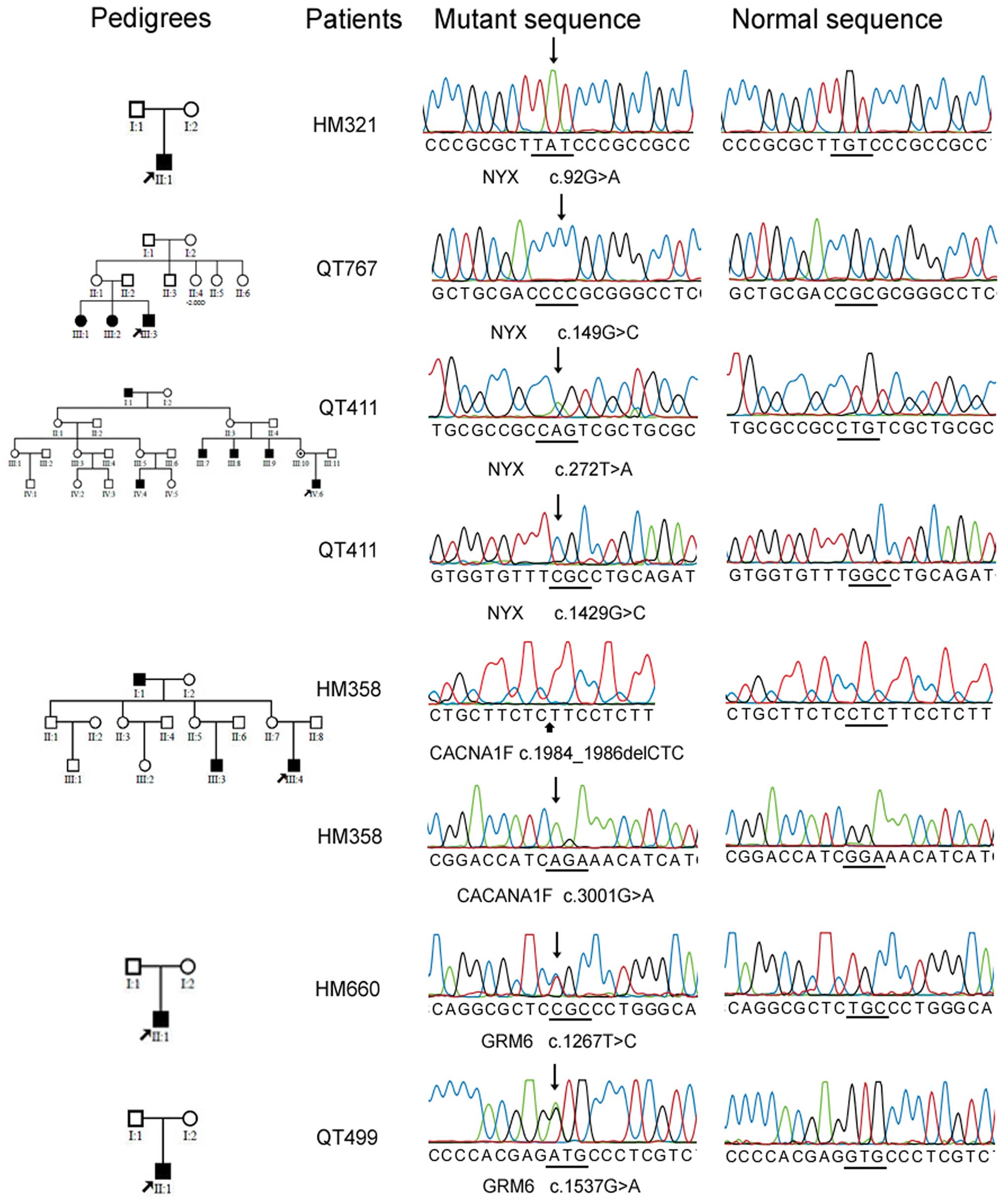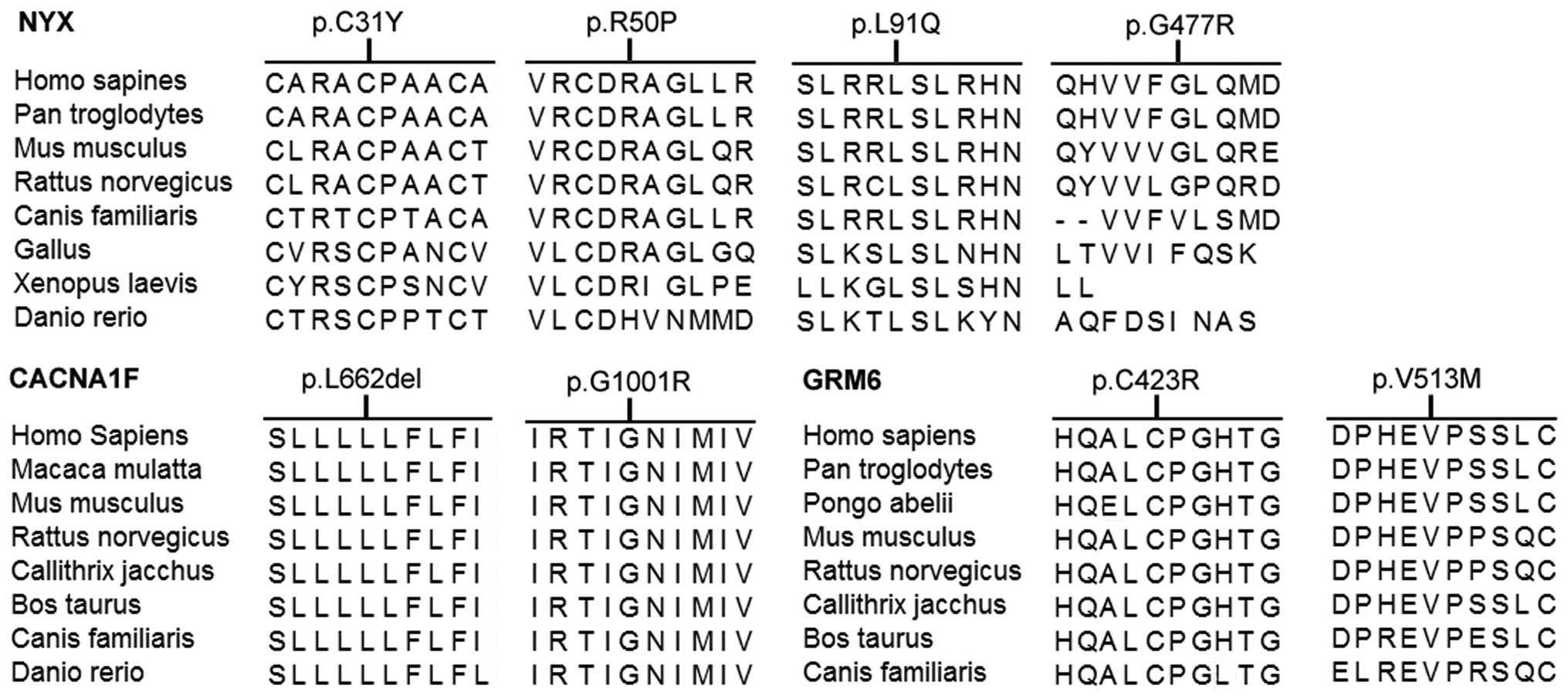Mutation screening of TRPM1, GRM6, NYX and CACNA1F genes in patients with congenital stationary night blindness
- Authors:
- Published online on: June 20, 2012 https://doi.org/10.3892/ijmm.2012.1039
- Pages: 521-526
Abstract
Introduction
Congenital stationary night blindness (CSNB) is a clinically and genetically heterogeneous group of inherited retinal disorders characterized by nonprogressive impaired night vision and sometimes accompanied with other ocular symptoms, including myopia, nystagmus and strabismus (1). Electroretinogram (ERG) recordings can classify CSNB into two groups, complete CSNB (cCSNB or CSNB1) which show the complete absence of rod pathway function and incomplete CSNB (icCSNB or CSNB2) which is caused by abnormal rod and cone pathway function (2). CSNB can be transmitted as autosomal dominant (adCSNB), autosomal recessive (arCSNB), or X-linked recessive traits (xlCSNB). To date, 12 genes have been reported to be implicated in CSNB (RetNet, http://www.sph.uth.tmc.edu/retnet/), including RHO (MIM 180380), GNAT1 (MIM 139330), PDE6B (MIM 180072), GRM6 (MIM 604096), TRPM1 (MIM 603576), SLC24A1 (MIM 603617), CABP4 (MIM 608965), CACNA2D4 (MIM 608171), SAG (MIM 181031), GRK1 (MIM 180381), NYX (MIM 300278) and CACNA1F (MIM 300110) (3–27).
Four of the 12 genes, TRPM1, GRM6, NYX and CACNA1F, are involved in the signaling cascade from photoreceptors to adjacent bipolar cells (1). L-type voltage-dependent calcium channel α-1F subunit (encoded by CACNA1F), locating in the rod synaptic terminal, regulates the intracellular influx Ca2+ concentration, which influence the glutamate release from rods to bipolar cells (28). Metabotropic glutamate receptor 6, encoded by GRM6 (MGluR6), locating in a bipolar cell, receives the glutamate released from rods and activates an intracellular cascade that terminates in closure of TRPM1 (encoded by TRPM1) (4,29). Nyctalopin (encoded by NYX) may interact with TRPM1 but the exact function is yet to be identified (30–32). Any abnormality in the cascade will lead to the signal transduction defect with clinical phenotype of CSNB.
Mutations in the TRPM1, GRM6, NYX and CACNA1F genes have been frequently studied in Caucasian or Japanese populations (1,33). Mutation analysis of all these 4 genes at the same time are rare, especially in Chinese. In this study, Sanger sequencing were used to analyze the coding exons and their adjacent regions of the 4 genes in 24 unrelated Chinese patients with CSNB.
Materials and methods
Patients
Twenty-four unrelated patients with CSNB were collected from our Pediatric and Genetic Eye Clinic of the Zhongshan Ophthalmic Center. Written informed consent conforming to the tenets of the Declaration of Helsinki was obtained from each participant or their guardians prior to the study. The Institutional Review Board of Zhongshan Ophthalmic Center approved this study. Genomic DNA was prepared from leukocytes of venous blood samples as previously described (34).
Mutation screening
Eighty-six coding exons and their adjacent intronic regions in the TRPM1, GRM6, NYX and CACNA1F genes were analyzed by using Sanger dideoxy sequencing. Bioinformation of these 4 genes (Table I) obtained from the National Center for Biotechnology Information (NCBI, http://www.ncbi.nlm.nih.gov/). DNA fragments encompassing individual exon was amplified by polymerase chain reaction (PCR). The amplicons were analyzed with the ABI BigDye Terminator cycle sequencing kit version 3.1 (Applied Biosystems, Foster City, CA) using an ABI 3100 Genetic Analyzer (Applied Biosystems). Sequencing results from the patients and the consensus sequences from the NCBI Human Genome Database were compared using the CLC Main Workbench program (http://www.clcbio.com/) (35). Each variation was initially confirmed by bi-directional sequencing and then evaluated in 96 normal individuals. The description of the mutations follows the recommendations of the Human Genomic Variation Society (HGVS, http://www.hgvs.org/). The potential functional effect of an amino acid substitution due to a mutation was predicted using the PolyPhen-2 online tool (v2.0.23, http://genetics.bwh.harvard.edu/pph2/). Sorting of the intolerant from tolerant (SIFT) was also used to predict whether an amino acid substitution affects protein function based on sequence homology and the physical properties of amino acids (http://sift.jcvi.org/).
Results
Mutations in the 4 genes were detected in six of the 24 families with CSNB (Table II and Fig. 1), including 3 novel mutations in NYX, 1 novel mutation in CACNA1F, and 2 heterozygous mutations (one novel and one known) in GRM6. One mutation in NYX and one mutation in CACNA1F were compound hemizygous mutations. The mutations in each patient involve codons in which the encoded residues were well conserved (Fig. 2). These mutations were not detected in the 96 normal individuals. No mutation was detected in TRPM1. Clinical information of the patients with mutations are listed in Table III.
The c.92G>A (p.Cys31Tyr), c.149G>C (p.Ary50Pro) and c.[272T>A;1429G>C] (p.[Leu91Gln;Gly477Arg]) mutations in NYX were detected in an isolated case and 2 families with possible X-linked pattern of inheritance (Fig. 1), respectively. These variations are predicted to affect the function of the encoded protein. Segregation analysis of the compound c.[272T>A;1429G>C] (p.[Leu91Gln;Gly477Arg]) mutation in family QT411 confirmed the hemizygous mutation in other two affected patients (III7 and III9) and the heterozygous status in the unaffected mother (Fig. 1). Patients with the three NYX mutations had a complete form of CSNB.
The c.[1984_1986delCTC;3001G>A] (p.[Leu662del; Gly1001Arg]) mutation in CACNA1F was detected in a patient, who had incomplete form of CSNB and a family history of the disease showing X-linked recessive pattern of inheritance (Fig. 1). This mutation is predicted to be probably damaging by PolyPhen-2.
Two heterozygous mutations in GRM6, c.1267T>C (p.Cys423Arg) and c.1537G>A (p.Val513Met), were detected in two isolated male patients with a complete form of CSNB (Fig. 1), respectively. The c.1267T>C (p.Cys423Arg) mutation is novel and predicted to be probably damaging (Table II). The c.1537G>A (p.Val513Met) mutation is predicted to be benign and has been previously detected in a Chinese patient with high myopia (36). These two mutations are located in the extracellular N-terminal domain that is vital in glutamate binding and the activation or inactivation of mGluR6 (37,38). However, mutations in another allele of these 2 patients have not been identified.
Discussion
In this study, analysis of the TRPM1, GRM6, NYX and CACNA1F genes in probands from 24 Chinese families with CSNB detected 6 mutations in 6 unrelated patients, including five novel and one known mutations. Three of the 6 mutations in NYX and 1 mutation in CACNA1F are likely to be the cause responsible for CSNB in those 4 families. However, additional study is needed to reveal how a heterozygous GRM6 mutation could associate with CSNB as mutations in GRM6 have been demonstrated to cause autosomal recessive CSNB.
TRPM1 is identified as the mGluR6-coupled cation channel in retinal ON-bipolar cells (39). Several studies have reported that TRPM1 mutations are associated with arCSNB in Caucasian or Japanese populations (9–11,33). No mutation was detected in the Chinese patients in this study although mutations in TRPM1 have been found in about half of the cases with CSNB1 (29).
The c.1267T>C (p.Cys423Arg) mutation in GRM6 is located in the ligand-binding domains of mGluR6 and probably will affect the folding of the protein (40). The c.1537G>A (p.Val513Met) in GRM6 was previously reported in high myopia patient without CSNB (36). We found this mutation in a CSNB patient with high myopia. The valine at codon 513 is located in the second conserved cysteine-rich domain (CRD) of the mGluR6 receptor, which is important in the intermolecular signal transmission (41). It is unclear why the same mutation is associated with high myopia alone in one patient but with CSNB and high myopia in another patient.
The c.92G>A (p.Cys31Try) and c.149G>C (p.Ary50Pro) mutations in NYX locate in the N-terminal cysteine-rich LRRs (leucine-rich repeats, LRPs). For the former, it is worth noting that a different mutation affecting the same codon, c.92G>C, has been reported before (21). The c.[272T>A;1429G>C] (p.[Leu91Gln;Gly477Arg]) would affect the second LRRs (total 11 LRRs) and the GPI-anchor region, respectively, and therefore may impair the structure or function of the encoded protein.
The (c.[1984_1986delCTC;3001G>A] (p.[Leu662del; Gly1001Arg]) mutation in CACNA1F is present in a patient with incomplete CSNB who has a family history of this disease showing X-linked recessive pattern. The deletion in this mutation would affect the domain II S5 region that is evolutionarily conserved. The missense change of this mutation involving the domain III S5 region is predicted to be probably damaging, which may disrupt the channel function (42).
In this study, 3 mutations in NYX, 1 mutation in CACNA1F, 2 mutations in GRM6 were identified in 6 of 24 Chinese patients with CSNB. The results expand the mutation spectrum of these genes. Further analysis of additional genes may enrich our understanding of the molecular basis of CSNB in those patients without mutation.
Acknowledgements
We would like to thank all subjects for their participation. This study was supported in part by the National Science Found for Distinguished Young Scholars (30725044 to Q.Z.) and the Fundamental Research Funds of State Key Laboratory.











